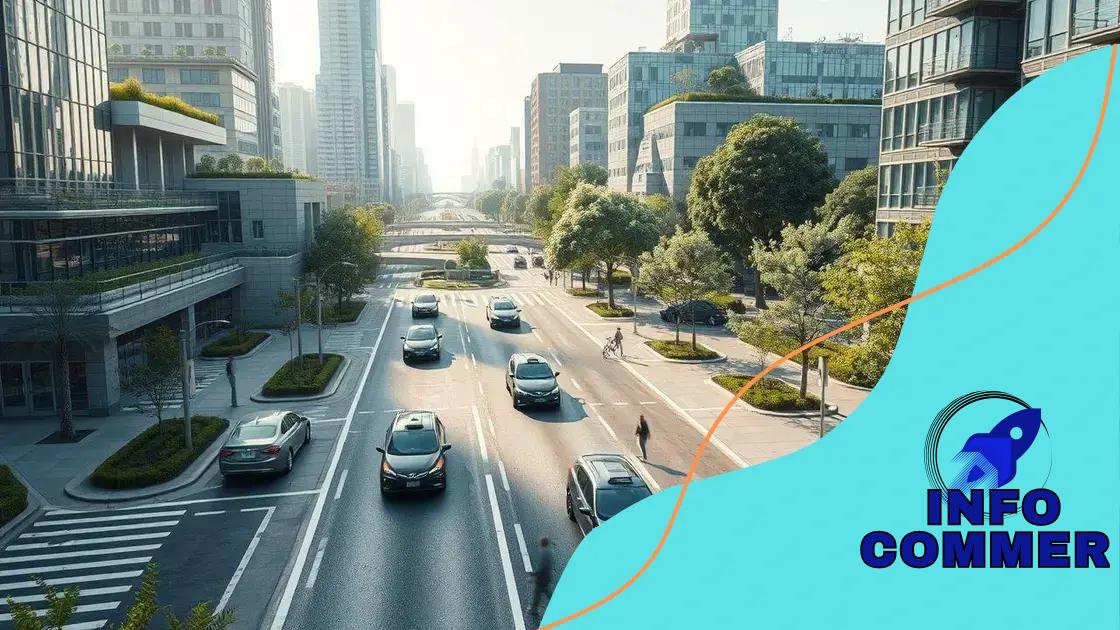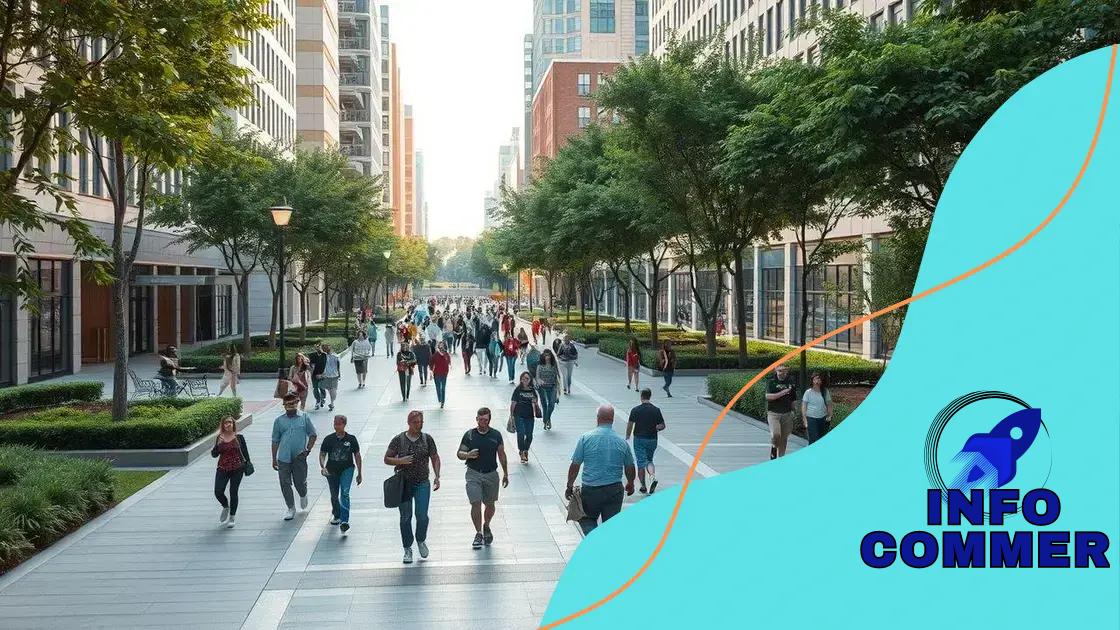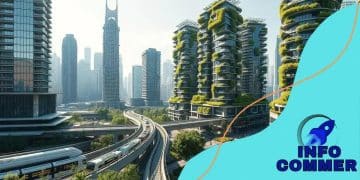Autonomous transportation’s effect on city designs

Autonomous transportation transforms urban designs by enhancing pedestrian mobility, reducing emissions, and promoting smart city technologies, leading to more sustainable and community-focused cities.
Autonomous transportation’s effect on city designs is a hot topic as cities adapt to new technologies. Imagine walking through neighborhoods where vehicles drive themselves safely while you enjoy a vibrant community around you. Curious about what this means for our cities?
The evolution of autonomous transportation
The evolution of autonomous transportation is fascinating, as it combines cutting-edge technology with everyday life. This transformation influences how we commute and design our cities. Since the advent of automobiles, our modes of transport have evolved significantly, paving the way for autonomous vehicles.
Key Milestones in Autonomous Transportation
Many breakthroughs have shaped this journey. From early automation in manufacturing to today’s sophisticated self-driving cars, the progress is remarkable. This innovation is reshaping not only vehicles but also urban life.
- Development of cruise control and lane-assistance systems.
- Introduction of self-parking technologies.
- Advancements in AI and machine learning for improved decision-making.
- Legal frameworks supporting autonomous operations.
Each milestone contributes significantly to enhancing safety and efficiency. The next stage includes fully autonomous systems, which promise to further change our travel experience. Imagine a city where public and personal transport can operate without human intervention. Would this change the way we perceive commuting?
Current Trends and Technologies
The landscape of autonomous transportation is continually changing due to new technologies. Manufacturers are integrating AI, sensor technologies, and data analytics into their designs. These advancements ensure that vehicles can navigate complex environments.
Furthermore, partnerships between tech companies and automotive manufacturers are on the rise. This collaboration accelerates the development of autonomous solutions. As we embrace these technologies, more cities are preparing infrastructure to accommodate such vehicles.
Ultimately, the future beckons with innovative possibilities. With the growth of autonomous transportation, urban designs will adapt, creating smarter cities. Are communities ready for this change? This evolution not only enhances transport but also encourages new urban paradigms that prioritize sustainability.
How city designs are changing
As city designs are changing, the impact of autonomous transportation is becoming more evident. These transformations guide how we plan urban spaces and shape our daily lives. With fewer cars needed on the streets, cities can explore innovative layouts that enhance community interaction.
Redefining Urban Spaces
Many cities are rethinking their layouts. They are prioritizing pedestrian walkways and green spaces over wide roads for cars. This shift promotes a healthier environment and a sense of community.
- More bike lanes and pedestrian zones are emerging.
- Parks and recreational areas are becoming central features.
- Public transportation hubs are placed strategically for easy access.
- Smart city technologies integrate traffic management and public transit.
These changes encourage social interaction. With fewer vehicles, streets can be safer and more inviting for families and friends to gather. Collaborative spaces, like plazas and community gardens, are becoming focal points in urban planning.
Emphasizing Sustainability
The push for sustainable designs is stronger than ever. With autonomous transportation, cities can implement eco-friendly initiatives. For example, electric vehicles can reduce pollution and reliance on fossil fuels.
Urban designs are now aiming to reduce carbon footprints. Green buildings and solar energy sources are gaining popularity. This movement aligns with the increasing global emphasis on environmental responsibility.
Imagine walking through a city filled with vibrant greenery while enjoying clean air. Autonomous transportation contributes to a cleaner and greener future. As cities evolve, they will continue to adapt and embrace these changes while promoting a sustainable urban lifestyle.
Impact on pedestrian mobility

The impact on pedestrian mobility is significant as cities adapt to autonomous transportation. With fewer vehicles on the roads, pedestrians enjoy safer and more accessible walkways. This shift encourages walking as a primary mode of transportation.
Improved Walkability in Urban Areas
As cities redesign their infrastructure, walkable areas are receiving more attention. Wider sidewalks and pedestrian-friendly zones help create inviting spaces. These changes encourage people to explore their neighborhoods on foot.
- Expanded sidewalks reduce congestion for pedestrians.
- Increased green spaces provide places to relax.
- Better lighting enhances safety during nighttime.
- Traffic calming measures lower vehicle speeds.
With enhanced walkability, communities foster connections among their residents. Local businesses also benefit from increased foot traffic, creating vibrant local economies.
Accessibility for Everyone
Another crucial benefit of improved pedestrian mobility is accessibility. Cities are focusing on ensuring everyone can walk freely. This includes designing spaces for people with disabilities and making public transit easier to access.
With autonomous vehicles, transport options for those unable to drive also expand. Ridesharing services can provide convenient solutions, enhancing overall mobility. As a result, more people can participate in community life and access essential services without relying on traditional vehicles.
Imagining a future where walking is safe and easy is becoming a reality. As pedestrian mobility increases, cities grow into friendly environments for everyone, creating a more integrated and sustainable society.
Sustainability and autonomous vehicles
The relationship between sustainability and autonomous vehicles is becoming increasingly important as we look toward greener urban futures. These vehicles offer innovative solutions to pressing environmental issues, changing how we think about transportation in our cities.
Reducing Emissions
One of the key benefits of autonomous vehicles is their potential to significantly reduce greenhouse gas emissions. By using electric power and optimizing routes, these vehicles can lower the carbon footprint associated with traditional internal combustion engines.
- Autonomous vehicles are often electric, promoting cleaner energy use.
- Smart routing helps minimize traffic congestion.
- Reduced stop-and-go driving cuts fuel consumption dramatically.
- Integration with public transport encourages fewer private vehicles.
This shift towards sustainable transportation aligns well with global efforts to combat climate change. Cities incorporating these technologies can make meaningful progress toward pollution reduction.
Encouraging Green Urban Development
The rise of autonomous vehicles encourages a rethinking of urban designs. Cities can create shared spaces that prioritize pedestrians and cyclists over cars. With fewer vehicles needed, planners can incorporate more green areas and recreational spaces.
The potential for sustainable urban development is immense. Community gardens, parks, and public art can flourish in areas formerly dominated by large parking lots and wide roads. This creates healthier and more enjoyable living environments for residents.
Additionally, autonomous vehicles making use of renewable energy sources help promote a culture of sustainability. By supporting car-sharing programs, they reduce the number of cars on the road, making cities less congested and reducing the need for extensive parking spaces.
In conclusion, the future of urban landscapes hinges on the integration of autonomous vehicles and sustainable practices. As cities continue to evolve, embracing these changes is essential for creating a greener world for future generations.
Future trends in urban planning
The future trends in urban planning are becoming more focused on integrating advanced technologies and sustainable practices. As cities evolve, planners are considering how to create environments that are not only livable but also resilient and adaptable.
Smart City Technologies
One significant trend is the rise of smart cities. These cities use technology to improve infrastructure, services, and overall quality of life. Sensors and data analytics help monitor traffic flow, energy consumption, and even air quality.
- Real-time data helps manage public transportation systems efficiently.
- Smart lighting adjusts based on pedestrian movement to save energy.
- Connected devices enhance communication between city services and residents.
- Integrated apps provide information for better public engagement.
These innovations lead to smarter resource management and more informed decision-making.
Focus on Mixed-Use Developments
Another trend is the shift towards mixed-use developments. Combining residential, commercial, and recreational spaces in one area promotes urban density and reduces the need for extensive transport. This type of planning leads to vibrant, walkable neighborhoods.
As cities embrace this model, they create environments where people can live, work, and play without relying heavily on cars. This approach fosters sustainability and a stronger sense of community.
Additionally, green building practices are being adopted. Using sustainable materials and energy-efficient designs is becoming standard. As cities prioritize eco-friendly construction, they help reduce their overall environmental impact.
With these forward-thinking trends, urban planners aim to create cities that are not only functional but also enhance the quality of life for all residents. By focusing on smart technology and sustainability, the urban areas of the future promise to be innovative and welcoming.
As cities embrace changes in transportation, the future looks bright for urban living. The integration of autonomous vehicles and sustainable practices will reshape our communities. With improved pedestrian mobility, enhanced infrastructure, and a focus on environmental responsibility, urban planning is set to create more livable spaces. These advancements promote not only efficiency and safety but also foster a sense of community among residents. As we look forward, the trends in urban planning will make our cities more adaptable, welcoming, and environmentally friendly.
FAQ – Frequently Asked Questions about Autonomous Transportation and Urban Planning
How do autonomous vehicles contribute to sustainability?
Autonomous vehicles are often electric and can optimize routes to reduce emissions, contributing to a cleaner environment.
What is the impact of pedestrian mobility on urban cities?
Enhanced pedestrian mobility leads to safer, more walkable areas, fostering community interaction and reducing traffic congestion.
What role do smart city technologies play in urban planning?
Smart city technologies improve resource management and help cities become more efficient by using real-time data to enhance city services.
How are mixed-use developments beneficial for communities?
Mixed-use developments combine residential, commercial, and recreational spaces, promoting vibrant neighborhoods and minimizing the reliance on cars.





